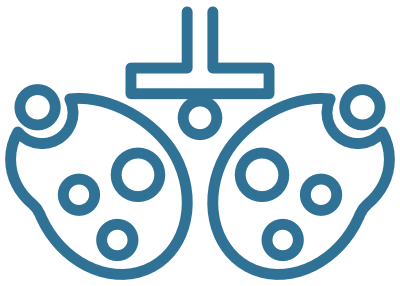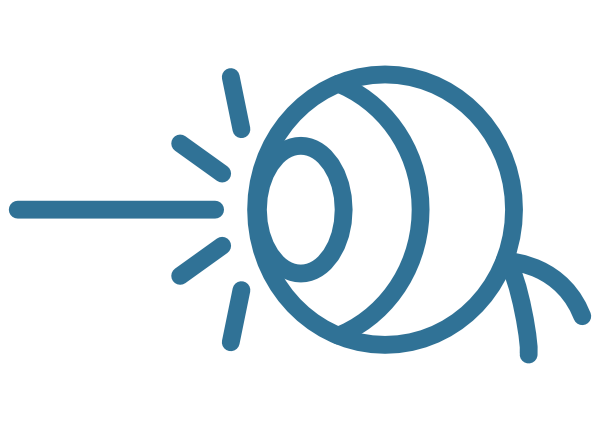
Eye exams for children are extremely important. Many experts report that from 5 to 10% of pre-schoolers and near 25% of school-aged children have some type of vision problem. Early detection and identification of a child’s vision problem is important because, if it goes untreated, there are some childhood vision problems can cause permanent vision loss.
When should kids have their eyes examined?
According to the American Optometric Association (AOA), infants should have their first eye exam at 6 months. After that exam, children should then have an eye exam at 3 years old, and right before they enter kindergarten or the first grade at about age 5 or 6 years old.
For children who are in school , the AOA recommends an eye exam every other year if there are no vision problems present. For children in Fort Collins, Loveland and Greeley who need eyeglasses or contact lenses eye exams should be scheduled yearly or according to their eye doctor’s recommendations.
These early eye exams also are important because children need the following basic visual skills for learning:
- Near vision
- Distance vision
- Eye teaming (binocularity) skills
- Eye movement skills
- Focusing skills
- Peripheral awareness
- Eye/hand coordination
There are some states in the US that make eye exams a requirement for all children entering the school system. This is because your child’s vision is extremely important and directly related to a successful experience in school.
Scheduling your child’s eye exam
Your family doctor or pediatrician likely will be the first medical professional to examine your child’s eyes. If there are any eye problems that are suspected during a routine physical examination, a referral may be made to an ophthalmologist or optometrist for additional evaluation. Eye doctors have very specific equipment and years of training to help them detect and diagnose any potential vision problems.
When you are scheduling an eye exam here in Northern Colorado, please choose a time during the day when your child is usually alert and happy (nap time is usually not a good time for an appointment for children who still take naps). Specifics on what to expect during an eye exam really depend on your child’s age. An exam will generally include health history, vision testing, determination of whether eyeglasses are needed, testing of eye alignment, an eye health examination and a consultation with you regarding the findings.
After the appointment has been made, you might be asked to fill out a case history form by mail, e-mail or by downloading and printing the forms from their website. You might also be given one when you check in at the doctor’s office if you have not filled out one before the appointment. The case history form will ask about your child’s birth history (also called perinatal history), and it will likely include questions such as birth weight and whether or not the child was full-term. Your eye doctor also may also ask if there were any complications that occurred during the pregnancy or delivery of the child. The form will also inquire about your child’s medical history, including any current medications that they are on, any supplements that they take and past or present allergies to food or medications.
In Fort Collins, Loveland and Greeley it is important to let your eye doctor know if your child has a history of prematurity, has any delayed motor development, engages in frequent eye rubbing, blinks excessively, fails to maintain eye contact, cannot seem to maintain a gaze (fixation) while looking at objects, has poor eye tracking skills or has failed a pediatrician or pre-school vision screening.
The eye doctor will also inquire regarding any previous ocular diagnoses and treatments involving your child. These may include possible surgeries and glasses or contact lens wear. Please be sure that you also inform your eye doctor about if there is a family history of eye problems requiring vision correction, such as nearsightedness or farsightedness, misaligned eyes (strabismus) or amblyopia (“lazy eye”).
Eye testing for infants
The development of a baby’s eye takes some time. In order to assess whether your infant’s eyes are developing at a normal pace, your eye doctor might need to use one or more of the following tests:
- Tests of pupil responses: the evaluation of whether the eye’s pupil opens and closes properly in the presence or absence of light.
- “Fixate and follow” testing: this will help determine whether your baby is able to fixate on an object (such as a light) and follow it as it moves. Babies should have this skill mastered by the time they are 3 months.
- Preferential looking: this test involves using cards that are blank on one side with stripes on the other side to attract the gaze of an infant to the stripes. Using this method of testing their vision capabilities can be assessed.
Eye testing for pre-school aged children
Pre-school children in Northern Colorado are able to have their eyes thoroughly tested even if they don’t yet know the alphabet or are too young or too shy to answer the doctor’s questions. Below are a few examples of common eye tests used specifically for young children:
- LEA Symbols: these are similar to an adult’s eye tests using charts with letters, with the exception of symbols are used instead of letters in these tests. Some of these symbols include an apple, house, square and circle.
- Retinoscopy: this test involves shining a light into the eye to observe how it reflects from the retina (the light-sensitive inner lining of the back of the eye). This test helps eye doctors determine the child’s eyeglass prescription.
- Random Dot Stereopsis: this test uses a dot pattern to determine the teaming capability of the eyes of the child.
Eye and vision problems that affect children
In addition to looking for nearsightedness, farsightedness and astigmatism (refractive errors), your eye doctor will also be examining your child’s eyes for any signs of eye and vision problems commonly found in young children. Some of these problems are listed below:
- Amblyopia: Also known as “lazy eye,” this issue is decreased vision in one or both eyes despite the absence of any eye health problem or damage. Some of the most common causes of amblyopia include strabismus (see below) and a significant difference in the refractive errors of the two eyes. Treatment of amblyopia might include wearing an eye patch on the dominant eye to strengthen the weaker eye.
- Strabismus. This is the misalignment of the eyes. Strabismus is most often the result of a congenital defect in the positioning or strength of muscles that are attached to the eye and which control eye positioning and movement. If this condition is left untreated, strabismus can cause amblyopia in the misaligned eye. Surgery might be necessary to treat this problem depending on how severe it is.
- Convergence insufficiency. This vision problem is the inability to keep the eye comfortably aligned during reading and other near task. Convergence insufficiency can often be successfully treated with vision therapy, a specific program of eye exercises that are practiced in the eye doctor’s office and then done regularly at home.
- Focusing problems. Some children have focusing problems (also called accommodation problems). They might have trouble changing focus from distance to near and back again (accommodative infacility) or have difficulty maintaining an adequate focus for reading (accommodative insufficiency). These focusing problems often can be successfully treated with vision therapy.
- Eye teaming problems. There are quite a few eye teaming (binocularity) issues that are more subtle than strabismus. Some deficiencies in eye teaming skills can cause problems with depth perception and coordination to name a few.
Vision and learning
Vision experts now say that up to 80% of what your child learns in school in Fort Collins, Loveland and Greeley is presented visually. Any undetected vision problems have the potential to put them at a significant disadvantage to their peers, can hurt their grades and damage their self-confidence. Please make sure to schedule a complete eye exam for your child before they start school.
For additional information or to schedule an appointment, please call (970) 204-4020 or click on the link on the side of the page. Learn more:
Read more about pediatric vision care.






